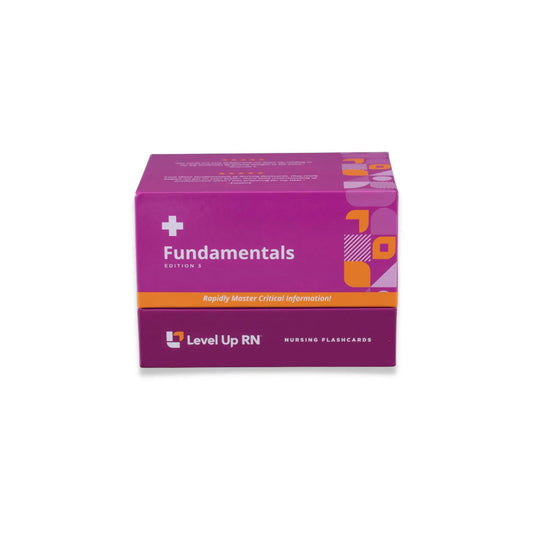In this article, we'll explain two important nursing fundamentals topics: informed consent, and a patient's right to refuse. You'll learn about the provider's vs. the nurse's role in informed consent, and nursing actions to take when a patient wants to leave against medical advice. The Fundamentals of Nursing video series follows along with our Fundamentals of Nursing flashcards, which are intended to help RN and PN nursing students study for nursing school exams, including the ATI, HESI, and NCLEX.
Fundamentals of Nursing - Flashcards
Informed consent
Informed consent is an important process that confirms a patient's voluntary decision to undergo a procedure or intervention. During the informed consent process, both the provider and nurse have specific roles to perform.
Check out our Psychiatric Mental Health article on Informed Consent in the mental healthcare setting.
Provider's role
When a patient is giving informed consent, the medical provider's role is to explain the nature, risks, and benefits of the procedure. The provider (NP, PA, MD, etc) must also explain the alternatives to the procedure and the risks and benefits of those alternatives. The provider must also assess the patient's understanding of the information—the patient must understand what has been explained. Most importantly, it is the provider's job to answer all patient questions regarding the procedure.
If a patient has questions about the procedure even after they have already given consent, the provider must be contacted to answer those questions. As a nurse, you can reinforce the provider's teaching, but you would not be the one to answer questions about the procedure for the purposes of informed consent.
Nurse's role
The nurse does not receive informed consent from a patient, the provider does. But, the nurse's role is to sign the patient's consent form as a witness. The nurse must confirm the patient received and understands the procedure, its risks, benefits, and alternatives, and most importantly, ensure the patient was competent and gave consent voluntarily.
The nurse should ensure that this consent was given voluntarily. This means that no one else besides the patient is giving consent—not family members, spouses, children, or medical professionals. The patient has not been coerced or forced into signing the consent. This patient understands, agrees, and wants to have this procedure done.
A nurse's role as a witness for informed consent is just one way that nurses act as advocates for their patients.
Documentation
When a patient is giving informed consent, all elements of informed consent must be documented on a form or in a patient's medical record. So, a signed consent form would be part of a patient's chart.
Who can give informed consent?
For patients to be able to give proper consent, there are some standards that must be met.
Oriented patients
If a patient is not oriented, they cannot be deemed competent to provide consent. A patient being oriented means they are functioning cognitively, and are alert and aware of what's going on.
In the Levels of Consciousness which you will learn in a head-to-toe assessment, a patient is Alert if they are awake, oriented, responding to questions appropriately, and following commands. This and more assessment topics are covered in our Health Assessment Flashcards for nursing students. Orientation is just one of the factors that goes into level of consciousness.
A patient would not be considered oriented to give consent if they are drunk, or high on drugs, on mood-altering medications like strong pain medicines or sedatives, or if they have a cognitive disorder such as dementia. These would impair the patient's ability to give consent.
For more specific teaching on mental health disorders and informed consent, check out our video on Psychiatric Mental Health: Informed Consent & Ethical Principles.
Adult patients
Usually, a patient must be 18 years old or older to give informed consent for a procedure, but there are some exceptions.
Some common exceptions with regards to the patient are if the underage patient is legally emancipated from their parents or guardians (legally granted the status of adult), married, or in the military.
Some other exceptions with regard to the procedure are if the underage patient requires mental health treatment, substance abuse treatment, or sexually-transmitted infection (STI) testing or treatment.
These age-based guidelines vary by state, so it's important to check in your own state.
Language comprehension and/or interpretation
Assuming the procedure explanation and documentation are given in English, a patient who does not speak English cannot consent without a medical interpreter available to translate. A patient must understand what they are consenting to.
It's important to know that a patient's interpretation services for the purposes of informed consent should be from a medical interpreter, not the patient's family members. A medical interpreter ensures the complete understanding of complex medical information to patients who speak a different language.
Who can revoke informed consent?
After a patient has already given informed consent, they still have the right to change their mind and decline treatment.
Refusal of treatment (right to refuse)
Patients who are competent to provide consent have the right to refuse medications or other therapies even if they were involuntarily admitted (except in emergency). This guideline helps protect a patient's autonomy.
Leaving Against Medical Advice (AMA)
A patient is Leaving Against Medical Advice (AMA) when they choose to leave the hospital or facility before the treatment team recommends discharge. Statistically, leaving AMA does place patients at a higher risk for readmission and morbidity/mortality, but it is their choice and right to do so.
Nursing actions for AMA
If a patient is choosing to leave AMA, you must notify the provider. Make sure to discuss the risks associated with leaving AMA with the patient. A patient will need to sign an AMA form, and if they refuse to sign one, you will need to document their refusal to sign.
In order to help protect this patient's health and safety, make sure to remove any indwelling medical devices like Foley catheters or IV catheters before they leave, and apply dressing where needed.
Remember that it is a patient's right to leave AMA, so you don't need to call security and you should NOT restrain them or block their ability to leave. Please note that inappropriate confinement of a patient with restraints, seclusion, or a medication acting as a chemical restraint, is considered false imprisonment and violates a patient's rights.



1 comment
Does a patient have the right to refuse blood work from a phychitrist?